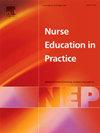Active methodologies in teaching the nursing process: Scoping review
IF 3.3
3区 医学
Q1 NURSING
引用次数: 0
Abstract
Aim
To map the use of active methodologies in nursing education for teaching the nursing process.
Background
The nursing process is a systematic approach essential for clinical reasoning, guiding nursing diagnoses and care planning, execution and evaluation. Its teaching requires strategies that engage students in active learning to foster evidence-based practice.
Design
Scoping review performed according to the Joanna Briggs Institute Manual for Evidence Synthesis.
Methods
The review involved seven steps: defining review questions, establishing eligibility criteria, designing search strategies, screening and selecting evidence, extracting data, analyzing results and presenting findings. Searches were conducted in July 2023 and updated in February 2024 on the databases Cumulative Index to Nursing and Allied Health Literature, Latin American and Caribbean Literature on Health Sciences, Excerpta Medica dataBASE, Medical Literature Analysis and Retrieval System Online, Scopus, Web of Science and Google Scholar. The review targeted graduate and undergraduate nursing students (Population), the nursing process (Concept) and active teaching methodologies (Context), guided by the PCC framework.
Results
The 101 included studies present key active strategies such as clinical simulation, case-based learning, web-based learning, problem-based learning, concept mapping, virtual simulation, electronic record systems, clinical practice and laboratory activities. Nursing assessment was the most frequently taught step, followed by diagnosis, interventions, evaluation and outcomes.
Conclusion
Active methodologies consistently demonstrated positive impacts on critical competencies, fostering critical thinking, clinical reasoning and judgment. Integrating these strategies with traditional approaches in undergraduate nursing curricula enhances the application of theoretical knowledge in clinical practice.
求助全文
约1分钟内获得全文
求助全文
来源期刊

Nurse Education in Practice
NURSING-
CiteScore
5.40
自引率
9.40%
发文量
180
审稿时长
51 days
期刊介绍:
Nurse Education in Practice enables lecturers and practitioners to both share and disseminate evidence that demonstrates the actual practice of education as it is experienced in the realities of their respective work environments. It is supportive of new authors and will be at the forefront in publishing individual and collaborative papers that demonstrate the link between education and practice.
 求助内容:
求助内容: 应助结果提醒方式:
应助结果提醒方式:


